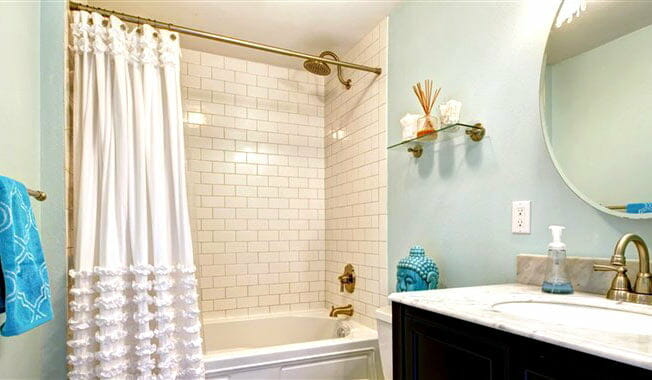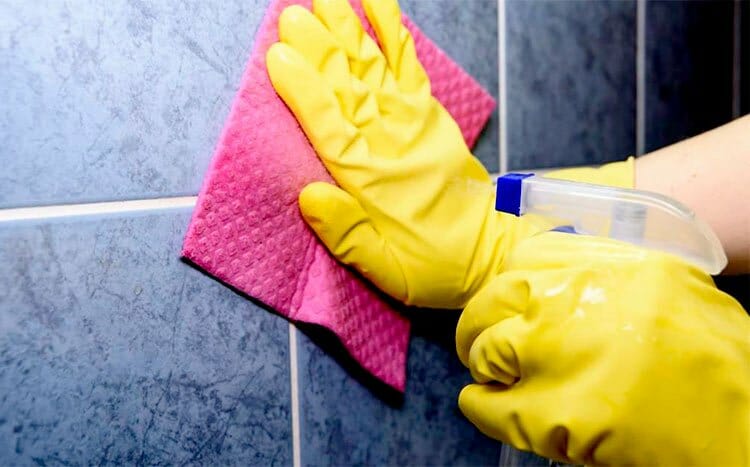Serratia marcescens, commonly known as pink mold because of its distinctive pink biofilm, is a bacterial species that travels through the air and typically inhabits moist areas like the spaces between bathroom tiles or shower curtains. It thrives by feeding on the mineral and fatty deposits left by soap and shampoo.
You can remove pink mold by applying a combination of baking soda and dish detergent on the affected surface followed by a good scrubbing with a soft-bristled brush. Kill off any lingering pink mold bacteria with diluted white vinegar or bleach solution.
Pink mold is a health hazard, especially in people with weakened or suppressed immune systems through contact with eyes or open wounds.
How to remove pink mold from shower curtains

Unclean shower curtains/liners aggregate large sections of soap scum and shampoo residue, which provides the food substrate for pink mold. However, a monthly machine- wash of your dirty shower curtain/liner using natural cleaning detergents and disinfectants can effectively remove pink biofilm from shower curtains.
Below is a step-by-step guide to removing pink mold from shower curtains/liners:
Machine washing.
You can machine-wash most plastic and vinyl shower curtains.
- Check the care instructions on your shower curtain/liner to confirm if it is machine-safe.
- Put on rubber gloves, goggles, respirator, and overalls before removing the shower curtain/liner from its hangings.
- Place the curtain/liner in a washing machine together with a couple of towels to prevent the curtain/liner from crinkling.
- Add ½ cup of regular liquid laundry detergent to the detergent dispenser.
- Sprinkle ½ cup of baking soda directly into the washer.
- Turn on the washer, and set the wash cycle to ‘Gentle’ to prevent damage to the curtain/liner.
- Add a cup of distilled vinegar into the washer before beginning the first rinse cycle to kill off the remaining pink mold.
- Remove the curtain/liner from the machine once the wash cycle is completed. Do not spin cycle.
- Hang the curtain/liner to drip dry outdoors until it is completely dry.
If the first wash is unsuccessful, repeat the washing process using ¼ cup detergent and ½ of bleach to replace baking soda and vinegar. Mixing bleach and vinegar creates toxic fumes; do not combine both cleaning agents.
Hand cleaning pink mold from shower curtain/liner.
You can hand clean your shower curtain/liner to remove pink biofilm. However, be sure to perform the task in a well-ventilated area (preferably outdoors).
- Put on rubber gloves, goggles, respirator, and overalls before removing the shower curtain/liner from its hangings.
- Fold the curtain/liner with the molded surface inwards to prevent pink mold from spreading to other indoor areas when moving the curtain/liner outdoors.
- Place the curtain/liner on a flat surface and spray with a hydrogen peroxide solution.
- Leave the hydrogen peroxide solution on the curtain/liner for 10 minutes, then rinse with water.
- Prepare and pour a liquid paste of equal parts baking soda and water on the shower curtain/liner.
- Grab a scrub brush and gently scour pink biofilm from the entire curtain/liner.
- Rinse with clean water and check for any remaining pink biofilm. Repeat the process if necessary.
- Turn the curtain/liner over and repeat the cleaning process.
- Hang the curtain/liner to drip dry outdoors until it is completely dry.
How to remove pink mold from hard shower surfaces.

The accumulation of water and soap stains can lead to a buildup of pink mold on hard surfaces in your shower, including walls, shower chairs, ceilings, and tile grouts. Most times, pink biofilm is easily removed with good scrubbing.
Below is a step by step guide to removing pink biofilm from bathroom walls:
- Prepare a liquid paste of ¼ cup of baking soda and one tablespoon of liquid dishwashing soap in a spray bottle. Use bleach to kill and remove a severe build-up of pink mold.
- Put on rubber gloves, goggles, respirator, and overalls to limit exposure to pink mold bacteria.
- Spray the affected areas with a cleaning solution. Spray liberally over areas with the most intense build-up, and leave for 15 minutes.
- Spray the cleaning solution on a nylon-bristled scrub brush and actively scrub patches of pink biofilm from pink molded surfaces. Scrub thoroughly to loosen and remove the biofilm.
- Scrub off the pink biofilm growing in the grout between the wall tiles with an old toothbrush. Search for cracks and crevices on your bathroom wall where pink biofilm lingers, and vigorously scrub these areas with your toothbrush to remove them.
- Rinse off the loosened biofilm with water. Alternatively, you can wipe down the cleaned surfaces with a wet towel to remove all the loosened pink biofilm and leftover paste.
- Turn on your bathroom ventilation fan for about 30 minutes after cleaning to dry out the shower completely.
Use this FREE service
HomeGardenGuides.com is a free service that quickly matches you with top-voted local mold removal specialists.
You can get 3 estimates fast by real certified experts in your area in just 2 minutes.
- Scroll to the top of the page and enter your Zip code.
- Answer questions about your mold removal job
- Your project details are forwarded to three local experts. They will send you a price estimate for the job and some friendly advice.
IMPORTANT: There is no obligation to hire. This is a free tool and service to be used at your pleasure.

How to remove pink mold from showerheads.
Showerheads can catch flecks of shampoo and soap scuds thrown upwards during shower time, enabling conditions for pinkish biofilm growth. We recommend removing the showerhead from the shower arm to clean out patches of pink mold properly.
Below is a step-by-step guide to removing pink biofilm from your showerhead:
- Unscrew the showerhead from the shower arm, and dip in warm water to soften embedded pink biofilm.
- Fill a bucket with distilled white vinegar and place the showerhead in it. Please leave it to soak overnight to kill off the pink mold bacteria.
- After letting the showerhead soak overnight, please remove it from the bucket and scrub pink biofilm off the face with an old toothbrush.
- Unclog blocked nozzles with a toothpick if needed.
- Wash the showerhead with clean water and re-attach to the shower arm.
Safety equipment and Items needed to remove pink mold
Never attempt to remove pink mold from your shower without donning safety gear and some form of protective clothing. Pink mold can cause severe ailments if it gets into your system. Your eyes and broken skin surfaces are the most vulnerable areas of your body. Also, pink mold can be removed with simple household tools. Ensure you properly clean or dispose of them after use.
Below is a list of safety gear and tools you need to kill and remove pink biofilm from your shower properly:
- A pair of rubber gloves (preferably forearm length)
- Full safety goggles without any side openings.
- A respirator.
- Disposable overall, although an easily laundered outer clothing covering your arms and legs will suffice.
- Plastic bristles soft brush
- Spray bottle
- Towels
- An old toothbrush
- Vinegar/bleach
- Baking soda
- Water.
How to prevent pink mold
Keeping pink biofilm at bay requires keeping moisture from your shower. It sounds daunting, but by adopting regular cleaning practices, you can eliminate pre-existing conditions in your shower that promote mold growth.
Below is a general cleaning checklist that can prevent the reappearance of pink biofilm on shower surfaces:
- Run your bathroom exhaust fan when taking a shower, and leave it running for 30 minutes after showering to reduce moisture levels in your bathroom.
- Use a spray bottle to disinfect your shower surfaces with bleach or vinegar solution at least once every week to kill lingering pink biofilm and prevent its return.
- Wipe dry or squeegee your bathtub and shower surfaces each time you take a shower to remove soap or shampoo residue and to minimize moisture levels.
- Use a dry towel to wipe all objects in your shower, including shampoo containers, bath toys, cleansers, etc.
FAQ's
Is pink mold dangerous?
Pink mold is a dangerous bacteria that causes potentially lethal diseases when exposed to humans. Individuals with compromised immune systems are especially vulnerable to pink mold. People infected through the eyes and the open wounds on their skin develop mild to severe illnesses, including gastrointestinal conditions, respiratory and urinary tract infections, pneumonia, meningitis, bladder infection, endocarditis, and osteomyelitis (in heroin addicts).
Should I hire a professional or DIY?
Pink mold, which is mostly limited to showers in most homes, is easily removed using simple house cleaning techniques. Thus, the services of a mold removal specialist are not required to remove pink biofilm unless you have a really severe infestation. However, homeowners experiencing recurring pink mold problems or who live in 3-4 or more bathroom homes with each shower having moderate to severe pink mold infestations can hire a professional to identify the source of moisture and remove pink biofilm.
Does bleach kill pink mold?
Yes, using a potent chlorine bleach mixture can kill off pink mold on hard shower surfaces. However, take precautions when mixing bleach to avoid injury. Wear safety gloves when handling bleach and keep them out of reach of small children. Besides, toxic fumes are produced when you mix bleach and vinegar. Do not combine both cleaning agents.






